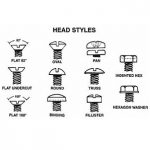There are many tolerance ranges in the manufacturing of screws, and this tolerance also has a certain allowable range index like our measurement error.
The tolerances of the non-standard screw industry include the tolerances of the production screw materials, the tolerances of the screw piers when the head is driven, the diameter tolerance of the screw head when the screw is punched, and the size tolerance of the screw head. Some screws have a tape guide.
At this time, the thickness of the meson also has a certain tolerance, and the size of the meson also has a tolerance. There are also tolerances when we rub the teeth. In short, there will be certain tolerances in the production of screws. It is allowed and reasonable within the tolerance range of a certain value.
The value of standard tolerance IT is basically any tolerance listed in the standard to confirm the size of the tolerance zone. The standard tolerance is divided into 20 levels, namely: IT01, IT02, IT1 to IT18.
IT stands for standard tolerance, and the number stands for tolerance level. IT01 tolerance value is small, precision; IT18 tolerance value, precision.
So how to mark the tolerance of non-standard screws?
When we are manufacturing parts, in order to make the parts interchangeable, the size of the parts is required to be within a reasonable range, which stipulates the limit size.
The actual size after manufacture should be within the specified limit size and small limit size range. The allowable size variation is called dimensional tolerance analysis, or tolerance analysis for short.
Non-standard screw standard tolerance standard: The value of standard tolerance label IT is basically any tolerance label listed in the standard to confirm the size of the tolerance label band.
The standard tolerance marking is divided into 20 levels, namely: IT01, IT02, IT1 to IT18. IT stands for standard tolerance marking, and the number means tolerance marking level. IT01 tolerance marked numerical value is small, precision; IT18 tolerance marked numerical value, precision.
Basic size: Design the given size.
Limit size: The two limit values of allowable size changes, which are determined based on the basic size.
Deviation: The algebraic difference of a certain actual size minus its basic size.
Limit deviation: refers to the upper deviation and the lower deviation. The algebraic difference obtained by subtracting the basic size from the limit size is the upper deviation; the algebraic difference obtained by subtracting the basic size from the small limit size is the lower deviation.
Dimension tolerance mark: allowable size variation. That is, the difference between the limit size and the small limit size; it is also equal to the algebraic difference between the upper deviation and the lower deviation.











